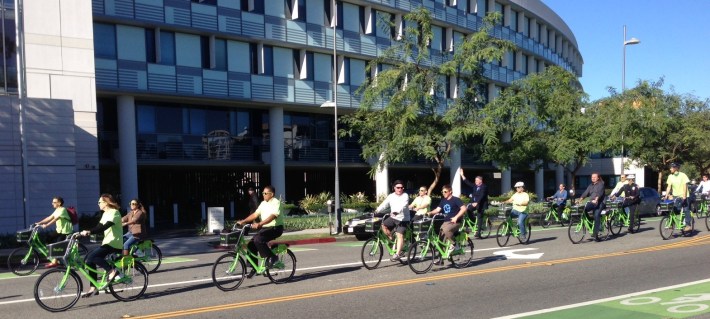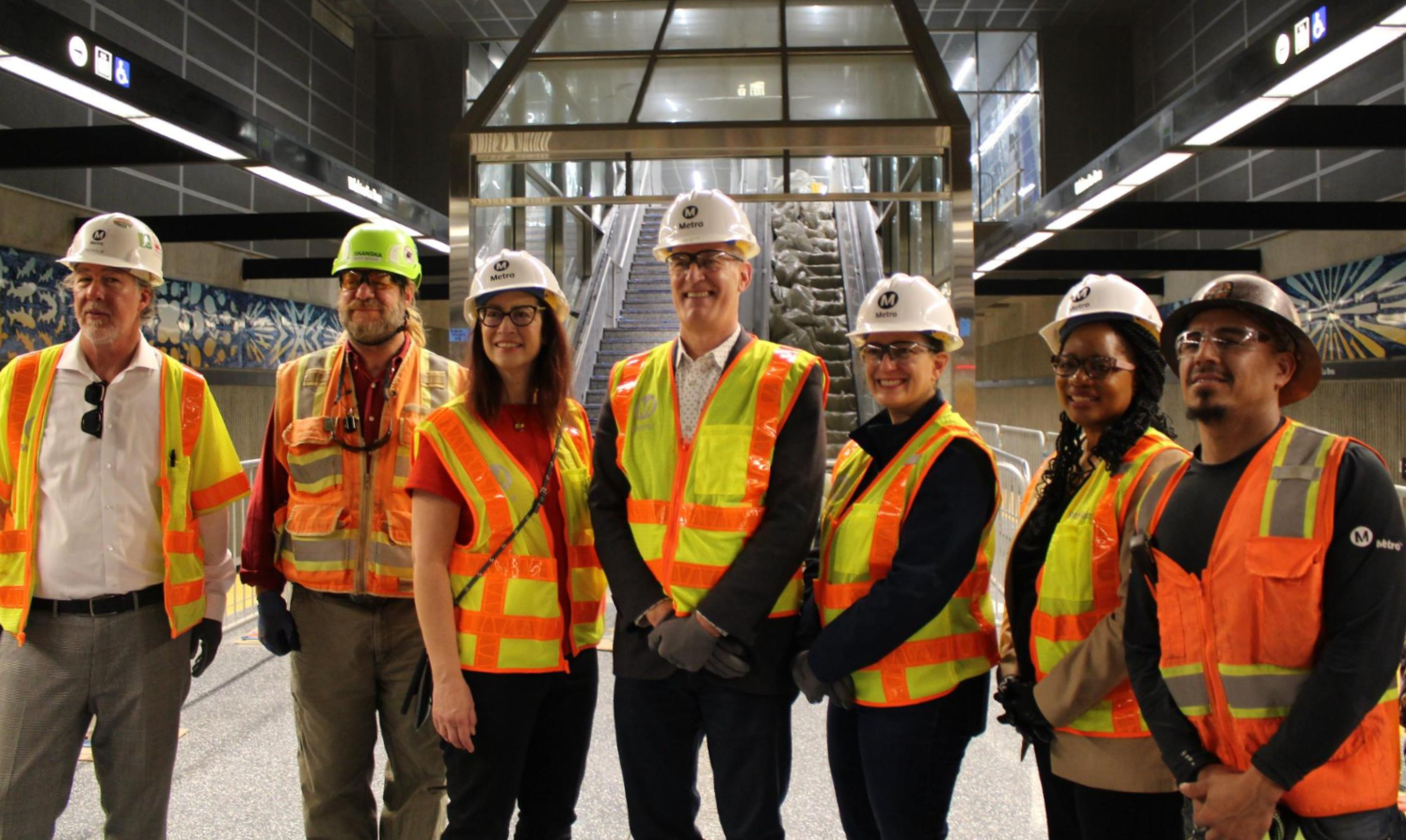Matt Martin is the Project Manager for the North American Bikeshare Association and the Director of Rosewood Bikes, a nonprofit program bringing bike resources to a poorly served area of Portland, Oregon. Prior to NABSA, Matt led the Community Bike Project Omaha, an Omaha nonprofit focused on transportation equity issues, where he helped bring bike-share to Omaha and served as Omaha B-cycle’s bike-share Managing Director.
The interview took place over email earlier this month.
Streetsblog L.A.: Tell us a little about your background. How did you come to the North American Bike Share Association?
I got into focusing on transportation policy expanding opportunities for bicycling in 2008, after a career of working in international security issues, as the perspective of my interests turned from global to local. While directing the Community Bike Project Omaha, I teamed together with a local health advocacy organization to create Omaha B-cycle and bring bike-sharing to Omaha. As a result of that, I met more of the national bike-share community. When NABSA reached out to me in 2015, I was happy to come aboard.
What is the North American Bikeshare Association? What do you do?
The North American Bikeshare Association (NABSA) exists to further bike-share and to support its members in North America and beyond. We host an annual conference that brings together bike-share system operators, local officials, vendors, and people seeking to learn about bike-sharing to share best practices, learn about new innovations, and gain insights on international trends.
We provide a range of services for our members - including expert webinars; a repository of guides, RFPs, contracts, and other documents; an internal discussion group; and daily support for the immediate questions and issues that can arise when planning or operating a bike-share system.
What is exciting about bike-shake? Explain some examples of the benefits that bike-share cities are seeing.
Whatever your usual way of getting around, bike-share can offer a convenient, green, inexpensive, and healthy option. Bike-share provides an alternative to single-occupancy vehicles and the problems they create for both the user and the city—cost, parking, and congestion. We've also seen them act as an alternative to public transit—when trains are offline for maintenance, those users can and do switch to bike-share.
Bike-share is often a “last mile” solution, used as part of a mix with other transportation modes. Users drive or ride transit in from the suburbs and use bike-share to complete their journey from the parking garage or bus stop. Even bicyclists can benefit, as bike-sharing eliminates the concerns over private bike maintenance and theft, when leaving a personal bike locked up outside.
Beyond these direct benefits, cities have enjoyed other urban planning benefits as well. As cities redesign their urban landscapes to encourage bike-share and active transportation, we have seen a virtual explosion of new pedestrian plazas, greenways, and urban renewal that has not only made our cities more efficient, but more beautiful as well.
Some bike-share critics assert that bike-share should not be implemented until after a top notch network of bike facilities are in place. What has been your experience? Can bike-share work where bike facilities are not quite like Davis or Holland?
As the number of U.S. cities that have implemented bike-share grows to nearly 100, it is clear that improvements in our urban transportation systems need not follow a rigid chronological order, but rather succeed by developing organically, in parallel, and opportunistically.
The range of cities where bike-share has been successful is one of its strongest proofs of concept. Some of bike-share's early adopters—Des Moines and Madison, for example—are not cities generally known for their urban bike infrastructure or culture, and some new systems—Portland, for instance—show that bike-share can be successful even in a city with mature public transit options and a vibrant bicycling culture. The fact that it already has or is being implemented in cities as diverse as Los Angeles, Chattanooga, Honolulu, Detroit, Omaha, and Boise is proof that there are many paths to a successful bike-share system.
There are studies critical of bike-share for its inability to meet mobility needs for low-income folks. The same is true for highway, roadway, park-and-ride, and other parking expenditures. Who does bike-share serve? How can bike-share systems better serve low-income communities?
Meeting the mobility needs of low-income and other disadvantaged populations has always been a challenge for any transportation system from single-occupancy vehicles to public transit and even providing appropriate transportation infrastructure has proved difficult. Our history is even replete with examples where transportation infrastructure (highways, train lines, and the like) has ironically (or cynically) been utilized to effectively delineate or segregate disadvantaged populations.
Bike-share has the potential to break out of this history in several important ways. First, as an infrastructure-light mode of transportation, bike-share does not require expensive, permanent, and lengthy improvements to implement. Secondly, bike-share is cost-competitive with transit. Third, equity concerns have already begun to drive creativity and flexibility regarding bike-share pricing structure and membership requirements, and as systems mature, this will continue to grow. Especially as bike-share becomes more integrated and seen as part of the public transit system, opportunities for transportation equity will only increase.
In L.A. County we have smart bike systems (in Santa Monica and Long Beach) and a smart dock system (in downtown L.A.) What is your opinion on smart bike vs. smart dock? What are the advantages and disadvantages of each? Are there other kinds of systems - how about peer-to-peer sharing or smart locks or other technologies?
As a young industry, bike-share has benefited by the implementation of a wide range of operational models and approaches. This has provided a level of choice for cities wanting to develop bike-sharing and allowed the new technologies and engineering to advance those options.
Smart systems add a host of benefits from previous bike-share iterations—improved bike tracking, better inventory control, greater sustainability, usage mapping, and the like. Smart docks provide durable stations where technologies and associated costs do not need to be implemented on each individual bike; smart bikes allow for more flexible docking options and provide more granular usage data. Peer-to-peer systems have modeled themselves after peer-to-peer car-sharing efforts and offer similar advantages, such as convenience, and disadvantages, such as checking in to the same check-out location. Moving forward, the one certainty is that bike-share will continue to develop along innovative lines and become more responsive and adaptive to users’ and cities’ needs.
What is next for bike-share? What innovations do you see on the horizon?
Some bike-share innovations are easily recognizable to the general public, such as smart bikes with GPS and solar panels powering user interfaces and integrated locks; some are more hidden, such as flexible pricing structures, which could help systems “auto-rebalance” by encouraging users to return bikes to less popular areas in return for a cheaper fare.
Electric-assist bikes will continue to improve and come down in cost, further broadening the appeal of bike-share. The integration of transit and bike-share user cards and the ability to access systems equally as users travel from city to city are likely outcomes that will make bike-share more seamless and accessible. Continued modifications to and adaptations of our urban built environments will continue to make our cityscapes more livable, efficient, and beautiful.
If you had a magic wand and could, overnight, change one thing about U.S. or California streets, what would it be?
The biggest change is already happening in cities across the country that embrace bike-share and active transportation, and that is attitudinal change.
Roads and public space are seen as less strictly defined solely by the demands of the automobile, and this “new” perspective (which actually has been the dominant perspective for all of human urban history up to the last 100 years), has freed our urban populations and planners to explore human-centric rather than auto-centric solutions to the challenges of how we move and operate within the urban environment.
Overnight changes can look attractive to those frustrated with existing strictures, but sustainable improvements require broad-based buy-in and common benefit—things which we see happening in city after city as they implement bike-share and other active transportation solutions.






